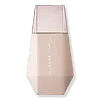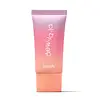What's inside
What's inside
 Key Ingredients
Key Ingredients

 Benefits
Benefits

 Concerns
Concerns

 Ingredients Side-by-side
Ingredients Side-by-side

Water
Skin ConditioningGlycereth-26
HumectantDimethicone
EmollientGlycerin
HumectantDipropylene Glycol
HumectantTriisostearin
Skin Conditioning1,2-Hexanediol
Skin ConditioningDipentaerythrityl Hexa C5-9 Acid Esters
Skin ConditioningBetaine
HumectantPhenoxyethanol
PreservativeIsodecyl Neopentanoate
EmollientSodium Hyaluronate
HumectantCetearyl Olivate
Caprylic/Capric Triglyceride
MaskingSynthetic Fluorphlogopite
Sorbitan Olivate
EmulsifyingHydroxyethyl Acrylate/Sodium Acryloyldimethyl Taurate Copolymer
Emulsion StabilisingMica
Cosmetic ColorantC14-22 Alcohols
Emulsion StabilisingAlumina
AbrasiveTocopheryl Acetate
AntioxidantSqualane
EmollientTromethamine
BufferingCarbomer
Emulsion StabilisingC12-20 Alkyl Glucoside
EmulsifyingPunica Granatum Pericarp Extract
Skin ConditioningPolysorbate 60
EmulsifyingTin Oxide
AbrasiveSilica
AbrasiveDisodium EDTA
Sorbitan Isostearate
EmulsifyingXanthan Gum
EmulsifyingOpuntia Tuna Fruit Extract
Skin ConditioningSilybum Marianum Extract
Skin ConditioningCI 77491
Cosmetic ColorantCI 77891
Cosmetic ColorantWater, Glycereth-26, Dimethicone, Glycerin, Dipropylene Glycol, Triisostearin, 1,2-Hexanediol, Dipentaerythrityl Hexa C5-9 Acid Esters, Betaine, Phenoxyethanol, Isodecyl Neopentanoate, Sodium Hyaluronate, Cetearyl Olivate, Caprylic/Capric Triglyceride, Synthetic Fluorphlogopite, Sorbitan Olivate, Hydroxyethyl Acrylate/Sodium Acryloyldimethyl Taurate Copolymer, Mica, C14-22 Alcohols, Alumina, Tocopheryl Acetate, Squalane, Tromethamine, Carbomer, C12-20 Alkyl Glucoside, Punica Granatum Pericarp Extract, Polysorbate 60, Tin Oxide, Silica, Disodium EDTA, Sorbitan Isostearate, Xanthan Gum, Opuntia Tuna Fruit Extract, Silybum Marianum Extract, CI 77491, CI 77891
Water
Skin ConditioningCaprylyl Methicone
Skin ConditioningNiacinamide
SmoothingPropanediol
SolventMica
Cosmetic ColorantIsoamyl Laurate
EmollientEthylhexyl Palmitate
EmollientPolysorbate 60
EmulsifyingCetearyl Olivate
Jojoba Esters
EmollientGlycerin
HumectantCaprylic/Capric Triglyceride
MaskingSorbitan Olivate
EmulsifyingPolyglyceryl-3 Beeswax
EmulsifyingAlumina
AbrasiveHelianthus Annuus Seed Oil
EmollientPentylene Glycol
Skin ConditioningPhenoxyethanol
PreservativeSoybean Glycerides
EmollientCetearyl Alcohol
EmollientCetyl Palmitate
EmollientSclerotium Gum
Emulsion StabilisingSorbitan Palmitate
EmulsifyingButyrospermum Parkii Butter Unsaponifiables
Skin ConditioningTocopheryl Acetate
AntioxidantXanthan Gum
EmulsifyingSodium Hyaluronate
HumectantSorbitan Oleate
EmulsifyingEthylhexylglycerin
Skin ConditioningTin Oxide
AbrasiveAscorbyl Palmitate
AntioxidantCI 77891
Cosmetic ColorantCI 77491
Cosmetic ColorantCI 77492
Cosmetic ColorantWater, Caprylyl Methicone, Niacinamide, Propanediol, Mica, Isoamyl Laurate, Ethylhexyl Palmitate, Polysorbate 60, Cetearyl Olivate, Jojoba Esters, Glycerin, Caprylic/Capric Triglyceride, Sorbitan Olivate, Polyglyceryl-3 Beeswax, Alumina, Helianthus Annuus Seed Oil, Pentylene Glycol, Phenoxyethanol, Soybean Glycerides, Cetearyl Alcohol, Cetyl Palmitate, Sclerotium Gum, Sorbitan Palmitate, Butyrospermum Parkii Butter Unsaponifiables, Tocopheryl Acetate, Xanthan Gum, Sodium Hyaluronate, Sorbitan Oleate, Ethylhexylglycerin, Tin Oxide, Ascorbyl Palmitate, CI 77891, CI 77491, CI 77492
Ingredients Explained
These ingredients are found in both products.
Ingredients higher up in an ingredient list are typically present in a larger amount.
Alumina is another name for the compound aluminum oxide. It is used as a thickener, absorbent, and abrasive.
As an absorbent, alumina can give a mattifying effect. It is used in mineral sunscreens to help coat nano-sized filters, such as titanium dioxide. By increasing the size of the UV filters, these ingredients stay on the skin for a longer time. By coating small sized ingredients, alumina helps thicken a product.
Alumina may be used as an abrasive, or exfoliant.
Alumina is naturally occurring in the mineral corundum. Certain varieties of corundum create rubies and sapphires. Corundum is also the crystalline form of alumina.
Learn more about AluminaThis ingredient is an emollient, solvent, and texture enhancer. It is considered a skin-softener by helping the skin prevent moisture loss.
It helps thicken a product's formula and makes it easier to spread by dissolving clumping compounds.
Caprylic Triglyceride is made by combining glycerin with coconut oil, forming a clear liquid.
While there is an assumption Caprylic Triglyceride can clog pores due to it being derived from coconut oil, there is no research supporting this.
Learn more about Caprylic/Capric TriglycerideCetearyl Olivate is an emulsifier and texture enhancer. It is derived from the fatty acids of olive oil and Cetearyl alcohol, and is biodegradable.
As an emulsifier, it is used to prevent oils and waters from separating. It can also
Manufacturers use the name Olivem 1000. This ingredient has been found to preserve the natural microbiome of skin. Having a healthy microbiome helps keep our skin healthy and protects against harmful bacteria. This ingredient is grouped with Sorbitan Olivate under the name Olivem 1000.
Learn more about Cetearyl OlivateCi 77491 is also hydrated iron III oxide. It's sole purpose is to give a red/pink hue to products.
Iron III oxides are classified as inorganic chemicals for coloring.
Synthetically created Ci 77491 is considered safer than those naturally found. This is because the synthetically created version may contain less impurities. Iron oxides are generally non-toxic and non-allergenic.
Learn more about CI 77491Ci 77891 is a white pigment from Titanium dioxide. It is naturally found in minerals such as rutile and ilmenite.
It's main function is to add a white color to cosmetics. It can also be mixed with other colors to create different shades.
Ci 77891 is commonly found in sunscreens due to its ability to block UV rays.
Learn more about CI 77891Glycerin is already naturally found in your skin. It helps moisturize and protect your skin.
A study from 2016 found glycerin to be more effective as a humectant than AHAs and hyaluronic acid.
As a humectant, it helps the skin stay hydrated by pulling moisture to your skin. The low molecular weight of glycerin allows it to pull moisture into the deeper layers of your skin.
Hydrated skin improves your skin barrier; Your skin barrier helps protect against irritants and bacteria.
Glycerin has also been found to have antimicrobial and antiviral properties. Due to these properties, glycerin is often used in wound and burn treatments.
In cosmetics, glycerin is usually derived from plants such as soybean or palm. However, it can also be sourced from animals, such as tallow or animal fat.
This ingredient is organic, colorless, odorless, and non-toxic.
Glycerin is the name for this ingredient in American English. British English uses Glycerol/Glycerine.
Learn more about GlycerinMica is a naturally occurring mineral used to add shimmer and color in cosmetics. It can also help improve the texture of a product or give it an opaque, white/silver color.
Serecite is the name for very fine but ragged grains of mica.
This ingredient is often coated with metal oxides like titanium dioxide. Trace amounts of heavy metals may be found in mica, but these metals are not harmful in our personal products.
Mica has been used since prehistoric times throughout the world. Ancient Egyptian, Indian, Greek, Roman, Aztec, and Chinese civilizations have used mica.
Learn more about MicaPhenoxyethanol is a preservative that has germicide, antimicrobial, and aromatic properties. Studies show that phenoxyethanol can prevent microbial growth. By itself, it has a scent that is similar to that of a rose.
It's often used in formulations along with Caprylyl Glycol to preserve the shelf life of products.
Polysorbate 60 is used to help stabilize products. It is a surfactant and emulsifier. These properties help keep ingredients together in a product. Surfactants help reduce surface tension between ingredients with different states, such as liquids and solids. Emulsifiers help prevent oils and waters from separating.
Polysorbate 60 is sorbitol-based and created from the ethoxylation of sorbitan. Ethoxylation is a chemical reaction used to add ethylene oxide. Sorbitan is a the dehydrated version of sorbitol, a sugar found in fruits.
In this case, the 60 comes from reacting 60 units of ethylene oxide with sorbitan.
Polysorbates are commonly used in medicine and foods.
Learn more about Polysorbate 60Sodium Hyaluronate is hyaluronic acid's salt form. It is commonly derived from the sodium salt of hyaluronic acid.
Like hyaluronic acid, it is great at holding water and acts as a humectant. This makes it a great skin hydrating ingredient.
Sodium Hyaluronate is naturally occurring in our bodies and is mostly found in eye fluid and joints.
These are some other common types of Hyaluronic Acid:
Learn more about Sodium HyaluronateSorbitan Olivate is created from the fatty acids in olive oil and sorbitol.
This ingredient is an oil in water emulsifier. It helps stabilize a product by preventing oils and waters from separating. Sorbitan Olivate also helps hydrate the skin.
Manufacturers sell sorbitan olivate under the name OliveM 1000. OliveM 1000 a multifunctional ingredient. It is self-emulsifying. According to a manufacturer, OliveM 1000 does not disrupt natural skin biome.
Due to its olive oil base, this ingredient may not be fungal-acne safe.
Learn more about Sorbitan OlivateTin Oxide is an inorganic oxide used to add opacity and volume to a product. In nature, it is already found in mineral form. The main ore of tin is an opaque and shiny mineral called casseterite.
Tin Oxide helps remove translucency in a product, or make it more opaque. Besides adding opacity, tin oxide is used for bulking to add volume.
Tocopheryl Acetate is AKA Vitamin E. It is an antioxidant and protects your skin from free radicals. Free radicals damage the skin by breaking down collagen.
One study found using Tocopheryl Acetate with Vitamin C decreased the number of sunburned cells.
Tocopheryl Acetate is commonly found in both skincare and dietary supplements.
Learn more about Tocopheryl AcetateWater. It's the most common cosmetic ingredient of all. You'll usually see it at the top of ingredient lists, meaning that it makes up the largest part of the product.
So why is it so popular? Water most often acts as a solvent - this means that it helps dissolve other ingredients into the formulation.
You'll also recognize water as that liquid we all need to stay alive. If you see this, drink a glass of water. Stay hydrated!
Learn more about WaterXanthan gum is used as a stabilizer and thickener within cosmetic products. It helps give products a sticky, thick feeling - preventing them from being too runny.
On the technical side of things, xanthan gum is a polysaccharide - a combination consisting of multiple sugar molecules bonded together.
Xanthan gum is a pretty common and great ingredient. It is a natural, non-toxic, non-irritating ingredient that is also commonly used in food products.
Learn more about Xanthan Gum